
Electrical telegraphs were point-to-point text messaging systems, primarily used from the 1840s until the late 20th century. It was the first electrical telecommunications system and the most widely used of a number of early messaging systems called telegraphs, that were devised to communicate text messages more quickly than physical transportation. Electrical telegraphy can be considered to be the first example of electrical engineering.

Jean-Maurice-Émile Baudot, French telegraph engineer and inventor of the first means of digital communication Baudot code, was one of the pioneers of telecommunications. He invented a multiplexed printing telegraph system that used his code and allowed multiple transmissions over a single line. The baud unit was named after him.

Telegraphy is the long-distance transmission of messages where the sender uses symbolic codes, known to the recipient, rather than a physical exchange of an object bearing the message. Thus flag semaphore is a method of telegraphy, whereas pigeon post is not. Ancient signalling systems, although sometimes quite extensive and sophisticated as in China, were generally not capable of transmitting arbitrary text messages. Possible messages were fixed and predetermined, so such systems are thus not true telegraphs.

An optical telegraph is a line of stations, typically towers, for the purpose of conveying textual information by means of visual signals. There are two main types of such systems; the semaphore telegraph which uses pivoted indicator arms and conveys information according to the direction the indicators point, and the shutter telegraph which uses panels that can be rotated to block or pass the light from the sky behind to convey information.
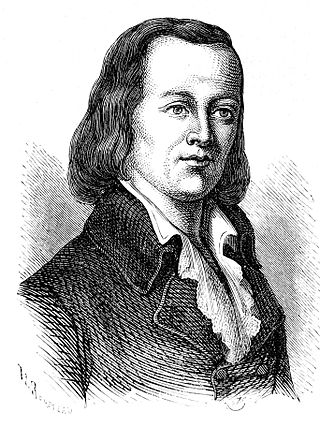
Claude Chappe was a French inventor who in 1792 demonstrated a practical semaphore system that eventually spanned all of France. His system consisted of a series of towers, each within line of sight of others, each supporting a wooden mast with two crossarms on pivots that could be placed in various positions. The operator in a tower moved the arms to a sequence of positions, spelling out text messages in semaphore code. The operator in the next tower read the message through a telescope, then passed it on to the next tower. This was the first practical telecommunications system of the industrial age, and was used until the 1850s when electric telegraph systems replaced it.
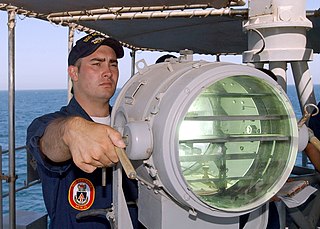
Optical communication, also known as optical telecommunication, is communication at a distance using light to carry information. It can be performed visually or by using electronic devices. The earliest basic forms of optical communication date back several millennia, while the earliest electrical device created to do so was the photophone, invented in 1880.
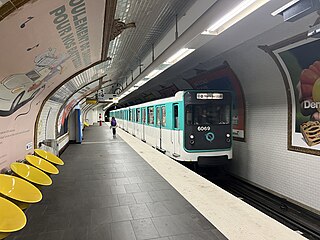
Télégraphe is a station on line 11 of the Paris Métro in the 19th and 20th arrondissements. It is named after the nearby rue de Télégraphe, which was once a chemin de ronde of the park of the Château de Ménilmontant. Its name comes from the optical telegraph invented by Claude Chappe (1763–1805) in 1792. This was the first practical telecommunications system, but was eventually replaced by the electric telegraph. Chappe installed the relay station, containing the telegraph's apparatus which he called a tachygraphe, on this peak of 128 meters altitude.
A telegraph code is one of the character encodings used to transmit information by telegraphy. Morse code is the best-known such code. Telegraphy usually refers to the electrical telegraph, but telegraph systems using the optical telegraph were in use before that. A code consists of a number of code points, each corresponding to a letter of the alphabet, a numeral, or some other character. In codes intended for machines rather than humans, code points for control characters, such as carriage return, are required to control the operation of the mechanism. Each code point is made up of a number of elements arranged in a unique way for that character. There are usually two types of element, but more element types were employed in some codes not intended for machines. For instance, American Morse code had about five elements, rather than the two of International Morse Code.

The history of telecommunication began with the use of smoke signals and drums in Africa, Asia, and the Americas. In the 1790s, the first fixed semaphore systems emerged in Europe. However, it was not until the 1830s that electrical telecommunication systems started to appear. This article details the history of telecommunication and the individuals who helped make telecommunication systems what they are today. The history of telecommunication is an important part of the larger history of communication.

Saint-Michel-Tubœuf is a commune in the Orne department in north-western France.
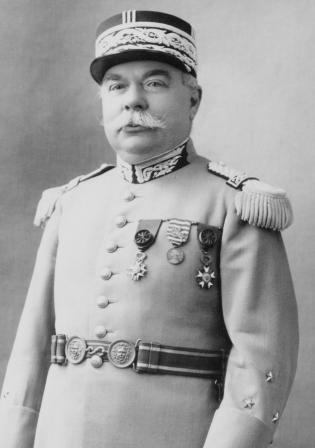
Louis Marie Jules Charles Bastien was a French Esperantist and a quartermaster in the French army. In 1899 he married Marguerite Pfulb (1879–1941); the couple had three daughters and two sons. In school he learned mathematics, classical French literature, Latin and Greek and learned to compose Latin verse. After a year of preparatory studies at l'Ecole Sainte-Geneviève in Versailles he entered l'Ecole Polytechnique in 1887 at the age of 17. Not having the maturity of his older classmates, he did not excel in his studies and, on graduation in 1889, had to content himself with a military career.

The Prussian Semaphore System was a telegraphic communications system used between Berlin and the Rhine Province from 1832 to 1849. It could transmit administrative and military messages by optical signal over a distance of nearly 550 kilometres (340 mi). The telegraph line comprised 62 stations each furnished with a signal mast with six cable-operated arms. The stations were equipped with telescopes that operators used to copy coded messages and forward them to the next station. Three dispatch departments located in Berlin, Cologne and Koblenz handled the coding and decoding of official telegrams. Although electric telegraphy made the system obsolete for military use, simplified semaphores were still used for railway signals.
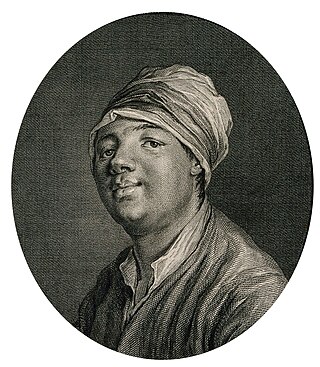
Jean-Baptiste Chappe d'Auteroche was a French astronomer, best known for his observations of the transits of Venus in 1761 and 1769.

The Fort du Télégraphe, or Fort Berwick, is located in the Maurienne valley on the road to the Col du Galibier between Valloire and Saint-Michel-de-Maurienne, at the Col du Télégraphe, dominating the valley of the Arc. The location at an altitude of 1,585 metres (5,200 ft) previously accommodated a telegraph of the Chappe system using articulating arms to send messages between Lyon and Milan, and after 1809, Venice. The fort has two entrances with drawbridges to allow access to different levels of the fort, with inclined ramps to allow easy movement of artillery pieces. When completed in 1884 after four years of construction, the fort was manned by 170 men, firing four artillery pieces at the main fort and four more at detached batteries.

Juliette Dodu was a legendary heroine of the Franco-Prussian War of 1870, and the first woman to be awarded the Legion of Honor. However, many doubts have been raised about her actions during the war, and her story remains controversial.

The Fort de Valros is a ruined small castle or fortress in the commune of Valros in the Hérault département of France. In the mid-19th century, the fort was the site of a semaphore station.

Semaphore is the use of an apparatus to create a visual signal transmitted over distance. A semaphore can be performed with devices including: fire, lights, flags, sunlight, and moving arms. Semaphores can be used for telegraphy when arranged in visually connected networks, or for traffic signalling such as in railway systems, or traffic lights in cities.
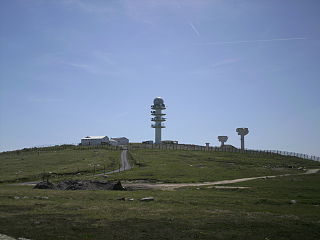
The Pierre-sur-Haute military radio station is a 30-hectare (74-acre) hill-top site used for French military communications. It has been in use since 1913. It is in the Sauvain and Job communes, with the boundary between the Rhône-Alpes and Auvergne regions passing through the site. There are three towers at the site. The tallest one is a 55-metre-high civilian telecommunication tower owned by Télédiffusion de France.

The Foy–Breguet telegraph, also called the French telegraph, was an electrical telegraph of the needle telegraph type developed by Louis-François-Clement Breguet and Alphonse Foy in the 1840s for use in France. The system used two-needle instruments that presented a display using the same code as that on the optical telegraph of Claude Chappe. The Chappe telegraph was extensively used in France by the government, so this arrangement was appealing to them as it meant there was no need to retrain operators.

The Paris pneumatic post was a pneumatic tube message-carrying service that operated in the French capital from 1866. It was established because of the popularity of the electric telegraph in the city which had led to the signal cables becoming overloaded and messages being sent by road. The pneumatic system allowed the telegraph companies to send messages underground through sealed lines laid in the Paris sewers, bypassing any traffic on the roads above. The network was taken into public ownership in 1879, under the Ministry of Posts and Telegraphs, and opened to messages sent by the general public. Messages continued to be considered officially as telegrams and for a fixed cost users could write a message on a "petit bleu" form to be sent anywhere in the city. After arriving at the office nearest the recipient it would be taken to their address by a courier.
























